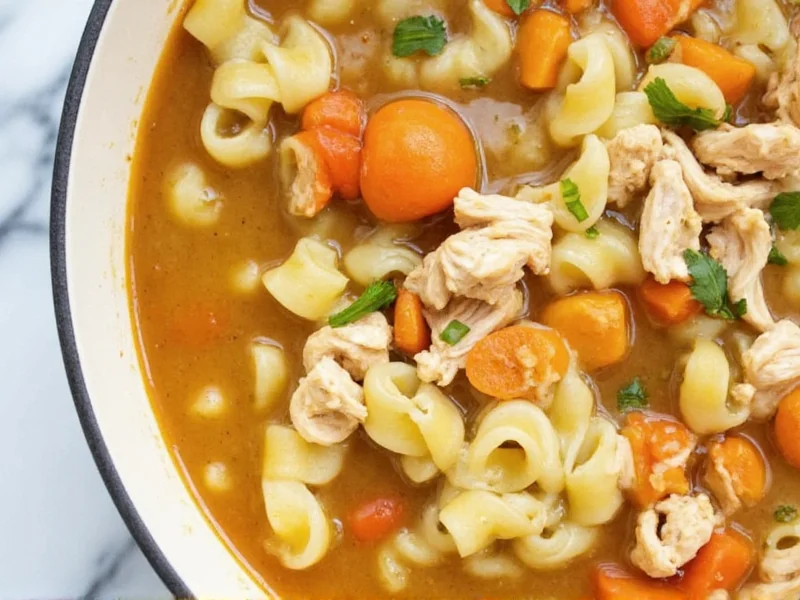Making delicious chicken noodle soup at home doesn't require hours of simmering or culinary expertise. This streamlined approach preserves the comforting essence of traditional chicken soup while eliminating unnecessary steps that frustrate home cooks. The secret lies in strategic ingredient selection and smart timing that maximizes flavor with minimal effort.
Why This Easy Chicken Noodle Soup Works
Many "quick" soup recipes sacrifice depth of flavor for speed, but this method maintains authenticity through three key principles:
- Strategic broth enhancement - Using quality store-bought broth as a base, then boosting it with aromatic vegetables and herbs
- Perfect noodle timing - Adding noodles at the precise moment to prevent mushiness
- Efficient chicken preparation - Using pre-cooked or rotisserie chicken without compromising freshness
Unlike complicated recipes requiring whole chickens and hours of simmering, this approach delivers genuine homemade taste with beginner-friendly simplicity. The result satisfies both your craving for comfort food and your need for a practical weeknight solution.
Simple Ingredients for Maximum Flavor
This easy homemade chicken noodle soup recipe uses pantry staples with options for customization:
| Core Ingredients | Quantity | Smart Substitutions |
|---|---|---|
| Low-sodium chicken broth | 6 cups | Homemade stock or vegetable broth |
| Cooked chicken, shredded | 2 cups | Rotisserie chicken or canned chicken |
| Egg noodles | 8 oz | Rice noodles, pasta, or zucchini noodles |
| Carrots, diced | 2 medium | Parsnips or sweet potatoes |
| Celery, diced | 2 stalks | Fennel bulb for different flavor profile |
| Yellow onion, diced | 1 medium | Shallots or leeks |
| Fresh parsley | 2 tbsp | Dill or thyme for variation |
Step-by-Step Preparation Guide
Follow these straightforward steps for perfect chicken noodle soup every time:
Prep Work (5 minutes)
Dice carrots, celery, and onion into uniform 1/4-inch pieces. Shred cooked chicken if using whole pieces. Measure all ingredients before starting - this quick chicken noodle soup recipe moves fast once cooking begins.
Cooking Process (25 minutes)
- Heat broth in large pot over medium-high heat
- Add diced vegetables and simmer 15 minutes until tender
- Stir in shredded chicken and egg noodles
- Cook 8-10 minutes until noodles reach al dente texture
- Remove from heat, stir in fresh herbs and season to taste
The entire process takes just 30 minutes from start to serving. For an even faster homemade soup with simple ingredients, use a kitchen dice for vegetables and pre-cooked chicken.
Pro Tips for Perfect Soup Every Time
Avoid common pitfalls with these expert techniques:
- Prevent noodle mush - Cook noodles directly in the broth but remove soup from heat immediately when noodles reach desired tenderness
- Boost flavor instantly - Add 1 tablespoon lemon juice or 2 teaspoons apple cider vinegar at the end to brighten flavors
- Thicken naturally - Mash some cooked vegetables against the pot side for creamier texture without flour
- Customize sodium - Use low-sodium broth and season at the end for perfect salt balance
Healthy Homemade Soup Benefits
This simple chicken noodle soup for beginners offers nutritional advantages over canned versions:
- No preservatives or artificial ingredients
- Higher protein content from real chicken
- Customizable sodium levels
- Added vegetables for vitamins and fiber
- No hidden sugars often found in commercial soups
The steam from homemade chicken soup actually contains compounds that may help reduce inflammation in the respiratory tract - a benefit lost in canned versions through processing.
Variations for Dietary Needs
Adapt this easy homemade soup recipe for different requirements:
- Gluten-free - Use rice noodles or quinoa instead of egg noodles
- Low-carb - Substitute spiralized zucchini or shirataki noodles
- Extra protein - Add white beans or chickpeas with the chicken
- Vegan option - Use vegetable broth and omit chicken (add mushrooms for umami)
Storage and Reheating Instructions
Proper storage maintains quality for future meals:
- Cool completely before storing (prevents condensation)
- Refrigerate for up to 4 days in airtight containers
- Freeze for up to 3 months (omit noodles if freezing)
- Reheat gently on stove - avoid boiling which makes noodles mushy
- Add fresh herbs after reheating for best flavor
For meal prep, make a double batch and freeze individual portions. This 30 minute chicken noodle soup becomes an instant healthy meal when time is limited.
Why Homemade Beats Canned Every Time
While canned soup offers convenience, this easy homemade chicken soup delivers superior qualities:
- Fresher, brighter flavor without metallic aftertaste
- Better texture control for noodles and vegetables
- No unnecessary preservatives or additives
- Customizable to personal taste preferences
- Therapeutic cooking process provides stress relief
The ritual of making soup connects us to generations of home cooks who understood that nourishment extends beyond physical ingredients. When you master this simple chicken noodle soup recipe, you gain more than a meal - you acquire a versatile skill that adapts to whatever ingredients you have available.











 浙公网安备
33010002000092号
浙公网安备
33010002000092号 浙B2-20120091-4
浙B2-20120091-4